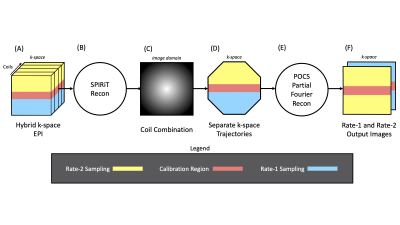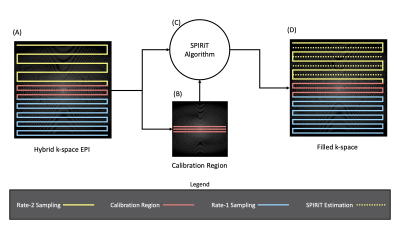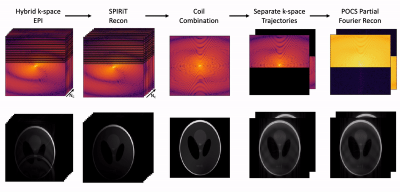1170
Hybrid K-space EPI (HyKE) Reconstruction for Accelerated Imaging1Radiology, Stanford University, Stanford, CA, United States, 2Bioengineering, Stanford University, Stanford, CA, United States, 3Electrical Engineering, Stanford University, Stanford, CA, United States, 4Radiology, Veterans Affairs Health Care System, Palo Alto, CA, United States
Synopsis
Echo planar imaging (EPI) is amongst the fastest ways to reduce scan times for long imaging techniques, but it is also susceptible to geometric distortion caused by phase accrual while traversing k-space over long echo times (TE). The objective was to determine the feasibility of a new EPI data acquisition technique that is able to: (1) maintain the SNR efficiency compared to traditional EPI methods, and (2) create a break in the trajectory linearity to allow for geometric distortion correction from one acquisition. Herein, we demonstrate a feasible reconstruction pipeline.
Introduction
Echo planar imaging (EPI) is amongst the fastest ways to reduce scan times for long imaging techniques, such as diffusion tensor imaging (DTI). These EPI-based quantitative imaging techniques are susceptible to geometric distortion caused by phase accrual while traversing k-space over long echo times (TE). Several different approaches are available to correct for this geometric distortion. One approach estimates a field map, by acquiring datasets with different TE’s, while another estimates a field map with opposing phase encode directions. Both of these correction methods require the collection of additional scans, increasing the exam time.EPI-based techniques are also susceptible to low signal-to-noise (SNR) due to the aforementioned long TE and frequently require additional averages to improve SNR. To improve SNR, several techniques have been introduced to reduce the TE in EPI scans including: partial Fourier [1], parallel imaging[2], and multi-shot imaging techniques[3]. All of these methods improve SNR with averaging, but the SNR efficiency associated with averaging is an expensive cost for both patients and clinics.
Given the known limitations of geometric distortion induced by EPI data acquisitions and corresponding SNR efficiency penalties, our objective was to determine the feasibility of a new EPI data acquisition technique that is able to: (1) maintain the SNR efficiency compared to traditional EPI methods, and (2) create a break in the trajectory linearity within our new EPI data acquisition technique that will possibly allow for geometric distortion correction from one acquisition.
Methods
A numerical phantom (128x128 with 8 coils) and coil sensitivity maps (Berkley Advanced Reconstruction Toolbox, v0.5.00) [4] was used to retrospectively apply a Hybrid k-space EPI (HyKE) sampling trajectory to the numerical coil data. The top “half” of k-space was sampled at rate-2 acceleration to reduce the TE and reach the center of k-space faster. The HyKE sampling scheme used 10 central lines of k-space, to serve as a calibration region for Iterative Self-Consistent Parallel Imaging (SPIRiT)[5]. The bottom “half” of k-space was then fully sampled. The HyKE sampling pattern was designed to break the gradient linearity in a single-shot acquisition. Figure 1 is a schematic of the image reconstruction pipeline, which shows a low-level overview of the different image reconstruction techniques used to extract two images from single-shot HyKE. The calibration region from the HyKE data was first extracted and used to generate weights from the SPIRiT kernel. Using the HyKE data and the newly generated weights, SPIRiT underwent 20 iterations to fill in the missing k-space lines (Figure 2). The coils were combined using the coil sensitivity maps and conjugate coil combination. Next, the coil combined k-space was separated into two subset k-spaces. One subset used the rate-2 sampling pattern, the k-space points estimated by SPIRiT, and the calibration region (i.e. top “half” of k-space). The other subset used only the fully sampled data and the calibration region (i.e. bottom “half” of k-space). Both subsets were each comprised of 69 out of the 128 lines of k-space (PF=54%). Each subset then underwent the same Projection on Convex Sets (POCS) individually for 10 iterations, resulting in two output k-spaces (Figure 3).SNR efficiency was measured to demonstrate the efficacy of this approach. Complex Gaussian noise was added to the original k-space data and SNR measurements were made using a traditional EPI approach (full k-space sampling with two averages) and the HyKE approach (HyKE k-space sampling with one average). Pixel-wise SNR efficiency maps, in addition to overlapping histograms, were then created for each approach. Difference maps between each approach were also made for SNR efficiency to distinguish the results.Results
A snapshot of the k-space and image data can be seen in Figure 4 displaying the feasibility of this pipeline with simulation data. Quantitative SNR efficiency maps show that the traditional EPI (median=17.8) and HyKE (median=16.4) are nearly equivalent, which is supported by the histogram analysis (Figure 5). It should also be noted that a large portion of the error comes at the sharp edges of the phantom, while the internal structure performs better with HyKE, which is visible in the difference maps.Discussion
These preliminary results suggest that it is feasible to generate equivalent SNR efficiency from the HyKE trajectory. These results also suggest that separation of trajectory linearity could enable different distortion patterns in the same encoding direction, which could be used to estimate a field map, thus enabling distortion correction in one acquisition. There are several limitations to the proposed method which need to be considered. This simulation was done, without taking any phase accrual into account, which could induce artifacts during the reconstruction pipeline. Secondly, although complex Gaussian noise was added to the simulation, additional signal attenuation from methods like DTI, might render the data below the noise floor, making this approach no longer feasible. These limitations are essential for validating this approach for quantitative EPI methods and new k-space trajectories.This work demonstrates the concept of reconstructing two images from a single acquisition, without losing SNR efficiency. Additionally, if it is possible to extract two different distortion patterns, the ability for a self-calibrating distortion correction could prove to be a useful tool for any EPI experiments.Acknowledgements
This project was supported in part by NIH R01 HL131823 and HL131975 to DBE.References
1. Xu Y, Haacke EM. Partial Fourier imaging in multi-dimensions: a means to save a full factor of two in time. J Magn Reson Imaging. 2001 Nov; 14(5):628-35.
2.Pruessmann KP, Weiger M, Scheidegger MB, Boesiger P. SENSE: sensitivity encoding for fast MRI. Magn Reson Med 1999; 42: 952–962
3. Hu Y, Wang X, Tian Q, Yang G, Daniel B, McNab J, Hargreaves B. Multi‐shot diffusion‐weighted MRI reconstruction with magnitude‐based spatial‐angular locally low‐rank regularization (SPA‐LLR). Magnetic Resonance in Medicine. 2020
4. Uecker M, Ong F, Tamir JI, et al. Berkeley advanced reconstruction toolbox. In: Proceedings of 23rd Annual Meeting of the International Society of Magnetic Resonance in Medicine, Toronto, Ontario, Canada, 2015. p. 2486.7.
5. Lustig M, Pauly JM. SPIRiT: iterative self‐consistent parallel imaging reconstruction from arbitrary k‐space. Magnetic resonance in medicine. 2010 Aug;64(2):457-71.
Figures




